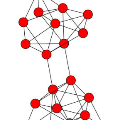Graph auto-encoders have proved to be useful in network embedding task. However, current models only consider explicit structures and fail to explore the informative latent structures cohered in networks. To address this issue, we propose a latent network embedding model based on adversarial graph auto-encoders. Under this framework, the problem of discovering latent structures is formulated as inferring the latent ties from partial observations. A latent transmission matrix that describes the strengths of existing edges and latent ties is derived based on influence cascades sampled by simulating diffusion processes over networks. Besides, since the inference process may bring extra noises, we introduce an adversarial training that works as regularization to dislodge noises and improve the model robustness. Extensive experiments on link prediction and node classification tasks show that the proposed model achieves superior results compared with baseline models.
翻译:事实证明,图形自动编码器在网络嵌入任务中是有用的。然而,目前的模型只考虑明确的结构,而没有探索与网络相连接的信息性潜在结构。为了解决这一问题,我们提议了以对抗性图形自动编码器为基础的潜在网络嵌入模型。在此框架下,发现潜在结构的问题是作为从部分观测中推断潜在联系的推论而形成的。一个描述现有边缘和潜在联系的优势的潜伏传输矩阵是根据通过模拟网络扩散过程而取样的影响级联得出的。此外,由于推论过程可能会带来额外的噪音,我们引入了一种对抗性培训,这种培训可以将噪音调出常规化,并提高模型的稳健性。关于链接预测和节点分类任务的广泛实验表明,拟议的模型与基线模型相比,取得了优异的结果。





